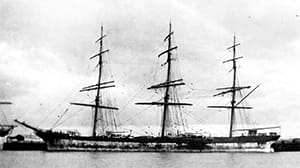From the latter part of the 19th century through the 1920s, square-rigged deepwater sailing ships still carried cargo competitively. Most of these cargoes — grain, rice, guano, wool, case oil, coal, timber, etc. — were carried by large sailing ships as tramps, meaning they picked up cargo wherever and whenever they could. Owners moved ships around like chess pieces across the oceans of the world regardless of weather or the time of year. These vessels sailed through the Roaring Forties, across the Atlantic, around the Cape of Good Hope and almost always around Cape Horn, where even in the summer months the passage is fraught with danger. One of these tramps was a 1,597-ton ship called Aberfoyle.
In January 1895, Aberfoyle departed Norway, bound for Melbourne, Australia. The three-master was loaded with timber, a crew of 22 and a captain named Robertson. Also aboard were his three young children — the captain’s beloved wife had recently died and he wanted to keep his family together. Captain Robertson was depressed and began drinking heavily. He was harsh to the men, resistant to their complaints, and sailed into a hurricane under full canvas. The first mate was washed overboard, leaving only the captain knowing how to navigate, which was not an uncommon circumstance at the time. The captain’s drunken behavior continued (he consumed 65 bottles of rum between January 25 and April 15 of that year). The crew, fearing for their safety, finally arrested Robertson and locked him up, depriving him of alcohol.
The sailmaker was put in charge due to his age and experience. Although a good sailmaker, the man knew nothing of navigation. He was smart enough to keep sailing east though, knowing that there had to be land somewhere. The captain was subsequently released, but soon he was up to his old ways — until that May when he drank carbolic acid, committing suicide.
According to Alan Villiers, Aberfoyle “felt her way around the north of Scotland through the north Atlantic and the south Atlantic without hitting the Cape Verde Islands.” This was with the captain drunk most of the time, the first mate gone and no qualified navigator on board.
On May 16, while approaching the coast of Australia, the ship hailed the steamer Tagliaferro and requested the loan of an officer to navigate the ship the remaining distance to Australia. By this time, the ship had been at sea four months. Tagliaferro lent an officer and 15 days later Aberfoyle sailed into Melbourne.
Let’s join Aberfoyle in the North Atlantic before things began to unravel. It is Feb. 10 and Captain Robertson is still on top of his game. He takes a noon sight at a DR of 50° 10’ N by 15° 40’ W. Height of eye is 20 feet. There is no index error and the Hs is 25° 15’.
A. What is the time of LAN GMT?
B. What is the Ho?
C. What is latitude?
Answers
A. LAN at DR is at 13:16:40 GMT
B. Ho is 25° 26.9’
C. Latitude is 50° 07.6’ N

